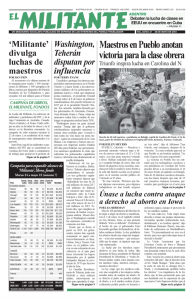The worst nuclear disaster in history took place in Soviet Ukraine 32 years ago when the Chernobyl power plant exploded April 26, 1986. The explosion blew apart the top of reactor No. 4, releasing large amounts of radiation, the core began to melt and an intense fire broke out. Winds carried clouds of radioactive dust over Ukraine, Belarus, Russia and other parts of Europe.
Some 8.4 million people were affected. Dozens of workers at the plant died within weeks. How many died since or were stricken with cancers and other illnesses is disputed, because Stalinist officials tried to cover up the facts. But they number in the tens of thousands, maybe more. Over 100,000 people were eventually relocated from the area and an official 18-mile-wide exclusion zone still surrounds the site.
The disaster highlighted the contempt for working people by the Stalinist government in Moscow. Chernobyl released 400 times more radiation than the murderous atomic bombs the U.S. rulers dropped on Hiroshima and Nagasaki in 1945.
Moscow decided to build the reactor without a containment structure that would have impeded the release of radiation. At first, they refused to release the fact the explosion took place. They delayed evacuating people from the area, lying about the severity of the explosion. And they showed total indifference to the lives of the hundreds of thousands of miners, other workers and soldiers — known as liquidators — who either volunteered or were ordered to join plant workers to try to put out the fire, contain the leaking reactor, relocate residents and begin to clean up the area.
Government bureaucrats did all in their power to cover up the scope of the disaster. They capped the Geiger counters measuring radiation at 3.6, the highest level where human presence was permitted. The actual reading was 15,000! “Top secret” instructions were issued to classify all data on the explosion and radiation levels.
The number of people taken to area hospitals mushroomed. By May 12 it was more than 10,000. So the health ministry issued new standards for acceptable radiation levels — 10 times higher than before. The majority of those hospitalized were then reclassified as healthy and sent home.
Only heroic deeds by workers, knowing full well they might have to pay with their lives, stopped things from becoming far worse.
The Chernobyl Power Station Firefighter Brigade was the first to respond. They had no protective gear and most of them died. Though they weren’t told the real character of the fire, survivors said they knew it was bad. “If we’d followed regulations, we would never have gone near the reactor,” firefighter Anatoli Zakharov said. “But it was a moral obligation.”
The reactor sat on top of a coolant pool of 5 million gallons of water. Five days after the explosion the highly radioactive core was still melting, separated from the water by the concrete floor that was slowly being burnt through. Had the core hit the water, it would have triggered a massive radiation-contaminated explosion, making northern Ukraine uninhabitable for more than a century and devastating much of Europe.
The pool had to be drained. Three plant workers — Alexei Ananenko, Valeri Bezpalov and Boris Baranov — volunteered to go down and try to open the drain. Using a flashlight in a myriad of pipes and valves, they waded in radioactive water up to their knees until they found the right ones and got them open. When the core burnt through, the pool was empty.
“To those who saved the world,” reads the inscription on the plaque of a monument to the liquidators in Chernobyl.
Stalinist officials still kept Chernobyl’s three other reactors running. Unit 2 was shut down in 1991 after a fire. Unit 1 closed in 1996 after the widespread appearance of thyroid cancers among children. Unit 3 ran until 2000, when public pressure finally forced Ukrainian officials to close it.
There are thousands of workers still there, preventing new leaks and preparing to decommission the plant, brought in by train daily from Slavutych, a town built for them outside the exclusion zone.
Militant reporters John Studer and Frank Forrestal visited Chernobyl and Slavutych in 2014, meeting with plant workers and some workers who’ve moved back near the plant. Their report, “Chernobyl: Tale of Two Opposite Class Responses,” is available on the Militant’s website.
In stark contrast to the Stalinist government’s callous indifference to the lives of working people is the response from Cuba’s revolutionary government. Between 1990 and 2011, Cuba provided medical care free of charge to more than 25,000 Chernobyl victims, overwhelmingly children from Ukraine. They were flown to Cuba, and treated at Tarará, a special medical facility built by Cuban workers’ voluntary labor.
“This kind of social support comes from the people,” Julio Medina, director of Cuba’s Chernobyl program, told the Militant. “Those values are the product of the revolution and its policies, our way of life.”

